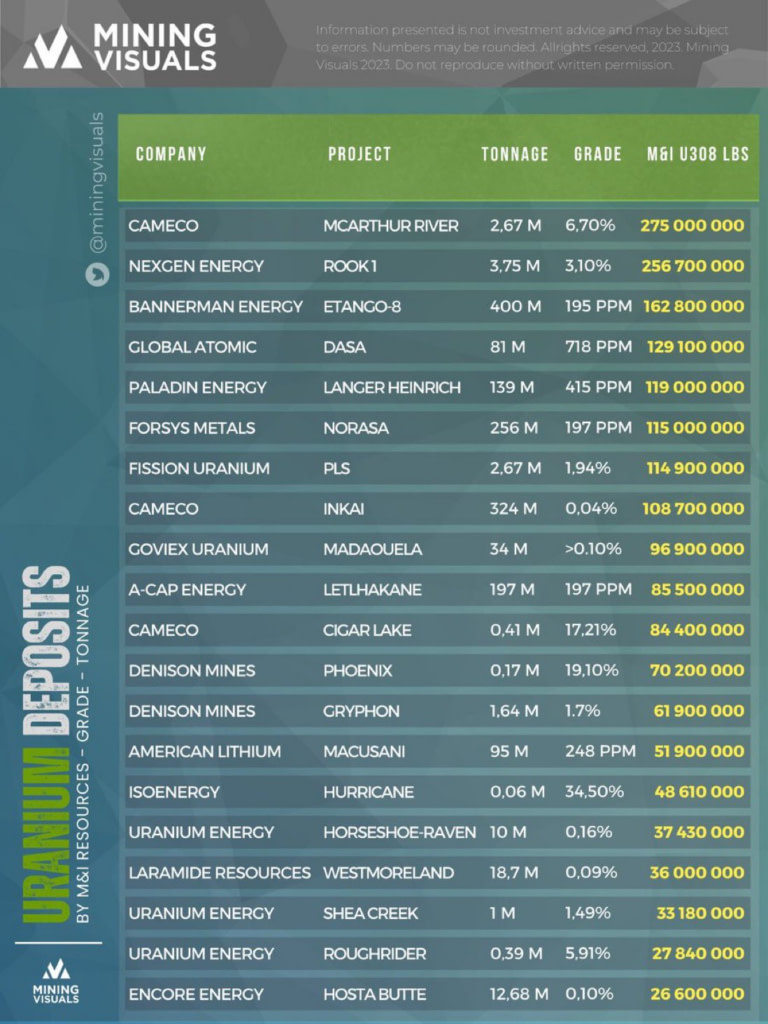Uranium is the fuel for the nuclear power industry. The volatile prices of fossil fuels and the continued need for reliable on-demand electricity, have spurred a resurgence of interest in nuclear power. That has investors looking for the best uranium stocks and ETFs.
Here’s a selection of potential uranium investments from around the world. Use them as a starting point for your research into this fascinating sector.
1. JSC National Atomic Company Kazatomprom (KAP.IL)
| Market Cap | $7.2B |
| P/E | 9.51 |
| Dividend Yield | 6.33% |
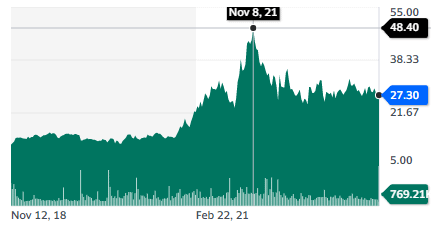
Kazatomprom is a Kazakh company and the world’s largest producer of uranium. It produces 22% of global uranium production from 14 mines. It is planning to expand its production by 2024.
It also produces rare metals (tantalum, niobium, and beryllium), representing 11% of the company’s revenues.
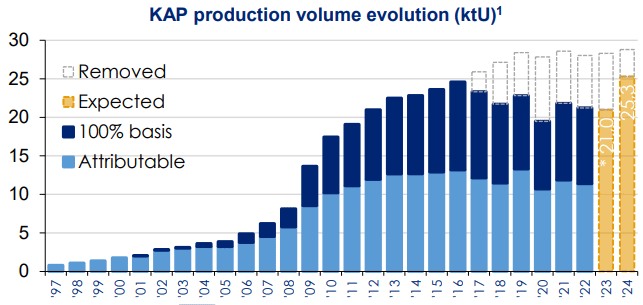
Kazatomprom has one of the lowest production cost figures of any uranium miner, actually owning ALL of the cheapest active uranium mines by production costs.
This has made Kazatoprom the most resilient uranium miner, as in case of a price downturn, it can keep producing profitably and push more costly mines out of the market.
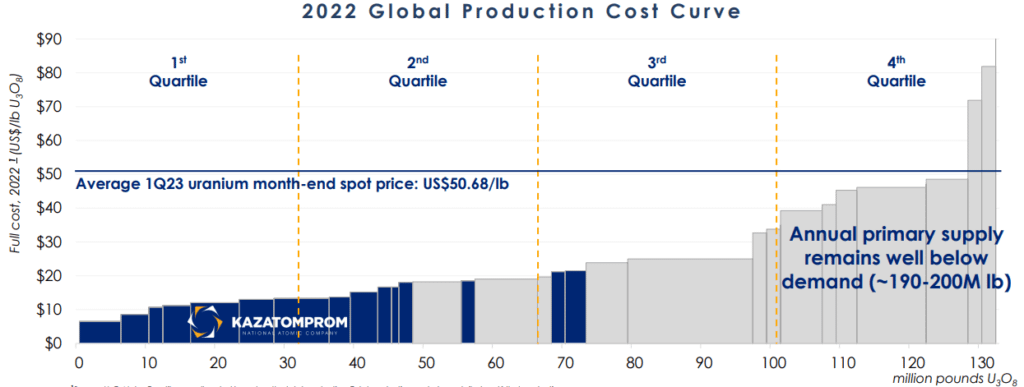
The company is also moving from mining to uranium investing and trading. It owns 1/3 of the physical uranium fund ANU and will open a new uranium trading hub in Alashankou, at the Kazakhstan-China border, in 2023.
The main risk associated with Kazatoprom is geopolitics. Kazakhstan experienced serious protests and civil disorder in early 2022 and is bordering both Russia and China. Its close proximity to both countries and links to their civilian and military nuclear programs could theoretically put Kazatoprom at risk of US sanctions in the future.
The company has a generous dividend policy, up to 75% of free cash flow if the ratio of net debt to adjusted EBITDA is below 1x. The company had negative net debt in 2022.
2. Cameco Corporation (CCJ)
| Market Cap | $12.2B |
| P/E | 96.03 |
| Dividend Yield | 0.32% |
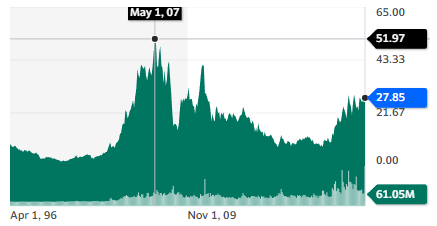
CCJ is the world’s second-largest uranium miner, with most production coming from its Cigar Lake mine. CCJ owns around half of this major mine, with the rest owned by French nuclear company AREVA (now Orano) and 2 Canadian companies.
It also restarted the River/Key Lake mine at the end of 2022 after putting it on hold in 2018. This mine (Cameco ownership is 69.8%) is where most of the future production growth for Cameco will come from.
Lastly, it owns 40% of shares in a Kazakh mine, Inkai, together with Kazatoprom.
Cameco has in its portfolio 3 idled mines, Rabbit Lake, Crow Butte in Nebraska, and Smith Ranch-Highland in Wyoming, all in maintenance since 2016.
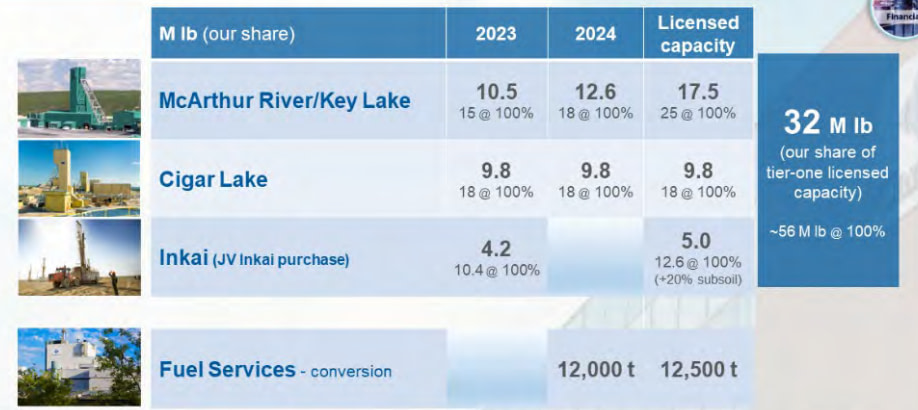
The Canadian company should benefit more from the shift toward “safer” supply sources than Kazatomprom or Russian uranium enrichment plants.
Canada is richer in uranium than Kazakhstan, with 424 million pounds of proven reserves, though its production remains smaller.
Cameco’s profile recently changed radically, with a downward move in the supply chain. Together with Brookfield Renewable, it acquired Westinghouse Electric Company (Cameco’s final ownership is 49%).
Westinghouse is the leading US builder of nuclear power plants, as well as a producer of refined uranium fuel. It is active in the increasingly dynamic SMR sector, with the AP300 SMR and the eVinci microreactor.
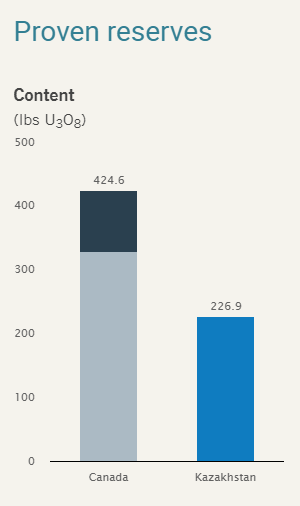
Boosted by higher uranium prices, the company grew its revenues by 27% in 2022, turning 2021’s net loss of $103M into 2022’s net earnings of $89M.
Cameco is a uranium company well positioned to answer a rise in demand, both for fuel mined in geopolitically “safe” jurisdictions and for increasing demand in nuclear power plants from Westinghouse.
Its production costs are higher than Kazatoprom’s, but the restarting of the River Lake mine and other idle projects gives it a lot of spare capacity ready to respond to shortages if needed.
3. NexGen Energy Ltd. (NXE)
| Market Cap | $1.89B |
| P/E | – N/A |
| Dividend Yield | – N/A |
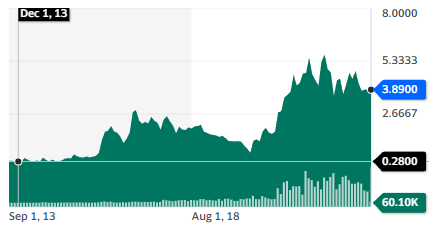
NextGen is a Canadian junior miner in uranium, aiming to develop the Rook I/Arrow Project in Saskatchewan into the largest low-cost-producing uranium mine in the world. NexGen Energy calculated the mine would have an impressive IRR (Internal Rate of Return) of 52.4%.
The mine has a 3.1% ore grade (the concentration of uranium).

The mine has an expected 10.7 years lifespan, and Saskatchewan is one of the most mining-friendly jurisdictions in Canada.
If all goes according to plan, including the mine being fully developed and uranium prices holding at the current level, this could make NexGen Energy one of the most undervalued mining companies in the world.
Of course, junior mining is a highly risky venture, so a serious discount on this ideal case seems reasonable.
It will also likely need to raise more capital before it has a running mine creating cash flows. Total initial capital costs needed for the project are expected at $1.3B, and the company has C$119M in cash in March 2023.
Depending on market conditions, NexGen Energy might become the new Cameco or a struggling junior miner. So this makes it a leveraged bet on uranium for patient investors willing to stomach a lot of volatility and risk.
4. Denison Mines Corp. (DNN)
| Market Cap | $910M |
| P/E | – N/A |
| Dividend Yield | – N/A |

Denison Mines is another Canadian junior miner, developing the Phoenix / Wheeler River mine. It also has a partial interest in several other mines in the region.
As shown on the map below, it is very close to other mega uranium mines in Saskatchewan:
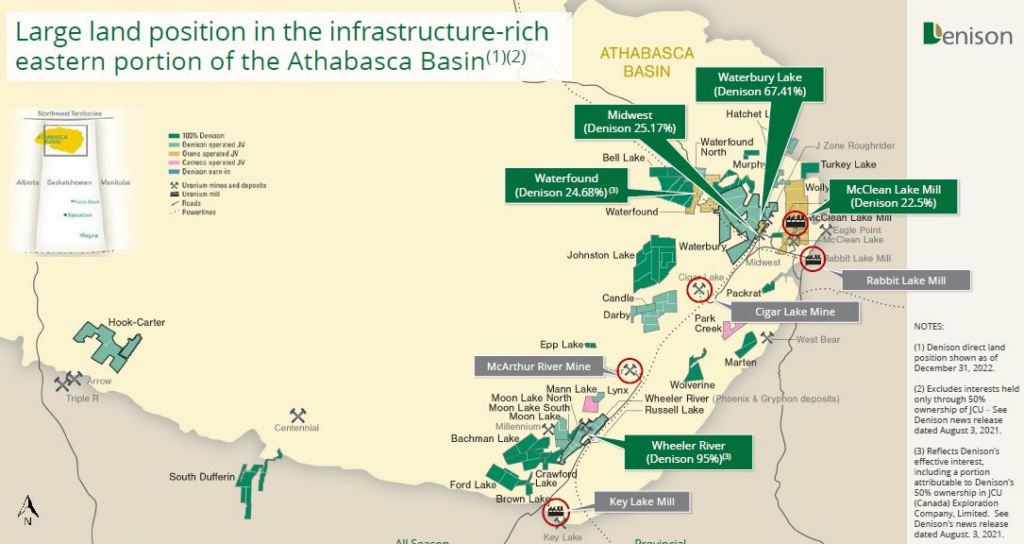
A key feature of the Denison Phoenix deposit is a very high ore grade, 19.1%, even higher than Cameco’s Cigar Lake.
This would put Denison’s flagship product among the world’s easiest deposits to mine and give it one of the world’s lowest production costs, on par with Kazatoprom’s best deposits, but with the geopolitical and jurisdictional safety of Canada.
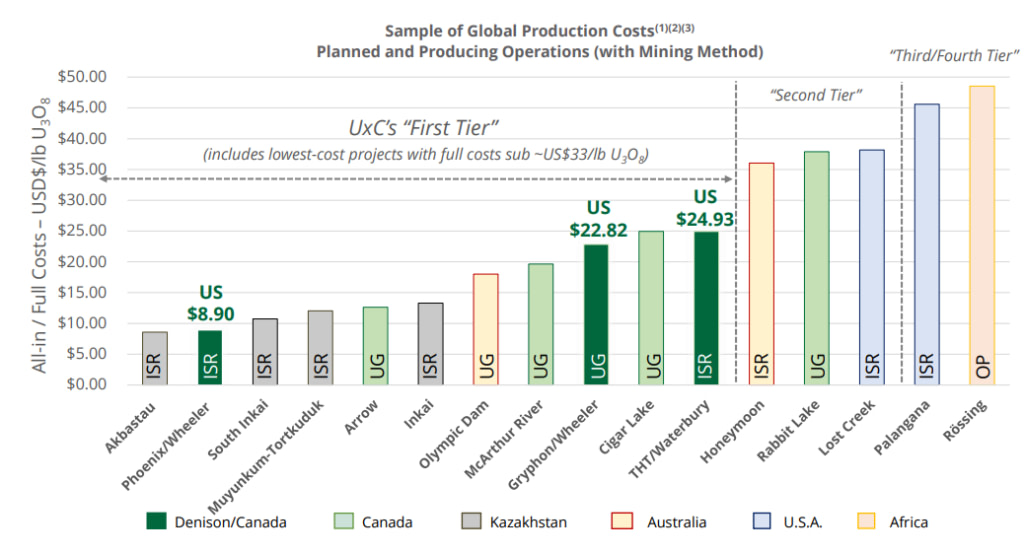
Denison is planning the development of its mining in stages to reduce the capital requirement and risks. It would start with the Phoenix deposit, and when this one starts producing uranium, it would launch the construction of the secondary Gryphon deposit.
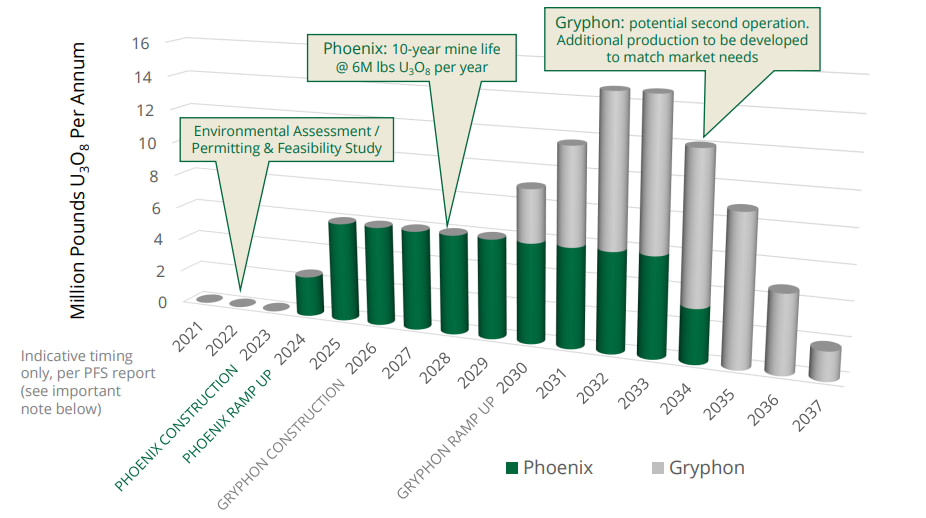
The company expects an initial capex for Pheonix of C$322.5M, which would create a very high pre-tax IRR of 71.5%. Gryphon would take C$623M, which would create a more moderate but still good pre-tax IRR of 31%.
In December 2022, the company had C$51M in cash, and 2.5 million pounds of uranium oxide (U3O8), bought at $29.66/lb (current prices are around $53/lb). So its working capital and investments are estimated at a value of C$216M.
Overall, Denison has a smaller deposit than NexGen Mines, but with higher ore concentration and lower future production costs (at least for the Phoenix part). It also has a somewhat better balance sheet and cash+investment when put into perspective of a much lower capex needed to reach first production.
So this is also a risky venture, like all junior miners, but with a potentially somewhat safer profile than NexGen Mines.
Even a crash in uranium prices would not endanger the finished mine. Even if it would hurt its profitability, its production costs would protect it from, for example, a market flooded by low-cost Kazatomprom mines.
However, with most of its liquidity in the form of stored uranium oxide, a crash in prices in the short term could severely endanger the company’s plans.
ETFs (Exchange Traded Funds)
If you prefer to have exposure to the sector as a whole, there are several uranium-focused ETFs available.
5. Global X Uranium ETF (URA)
An ETF with a strong focus on Western-produced uranium, with 23.2% of holdings in Cameco, 5.4% in NexGen Energy, 9.6% in Sprott Physical, 3.1% in Yellow Cake, and only 9.6% in Kazatoprom.
6. VanEck Uranium and Nuclear Technologies UCITS ETF (NUCL)
A nuclear ETF includes uranium miners like Cameco (15.9 % of holdings), but also nuclear-related industrials like BWX Technology, Mitsubishi, Hitachi, Fuji, Toshiba, and Samsung Corp.
7. Sprott Uranium Miners ETF (URNM)
This ETF is focused on uranium miners, with Cameco and Kazatoprom making 30% of holdings, 17% in physical uranium (12.7% in the Sprott Physical Uranium Trust and 4.4% Yellow Cake PLC), and the rest in more prospective smaller miners or junior miners.
8. Sprott Physical Uranium Trust (U.U)
The Sprott Physical Uranium Trust exists to provide direct exposure to uranium as a commodity without exposure to the operational risks inherent in mining. It currently holds 61.7 million pounds of U3O8 and charges a management and expense ratio of 0.7%.
9. Yellow Cake PLC (YCA.L)
Yellow Cake PLC exists to provide direct exposure to uranium as a commodity without exposure to operational mining risks. It currently holds 18.8 million pounds of U3O8.
Why Uranium?
Nuclear power is experiencing a resurgence, due to wildly fluctuating fossil prices and continued high demand for reliable electric power. New technologies like molten salt reactors, breeder reactors, or small modular reactors (SMRs)) promise safe, reliable power derived from uranium.
There are 60 nuclear reactors in construction, mainly in China, India, and Russia[1]. There are more to come, with China alone having 228 nuclear reactors in the planning stage[2]. Japan is also restarting its nuclear plants, which have been idle since the Fukushima incident. All of these reactors will need uranium.
Because the cost of uranium is only a low single-digit percentage of the cost of running a nuclear power plant, its price does not affect the quantity of energy generated or the plan for building new reactors.
Any shortage could send uranium prices to spike, as they have in the past, boosting the profitability of uranium mines.
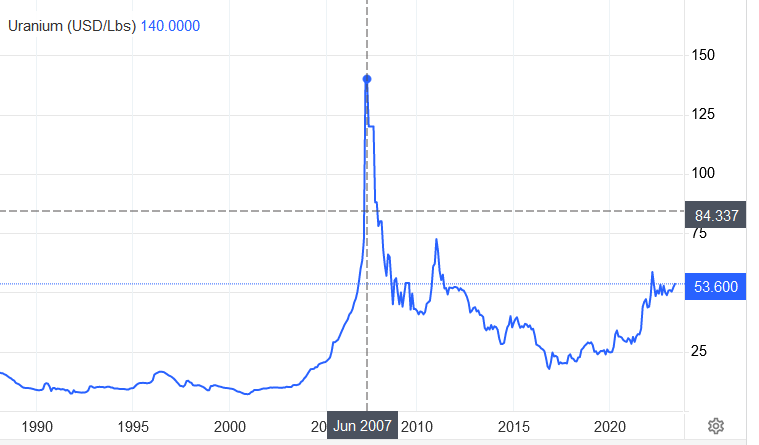
The uranium market is also expected to run into a tight supply in the next few years and a deficit after 2028.
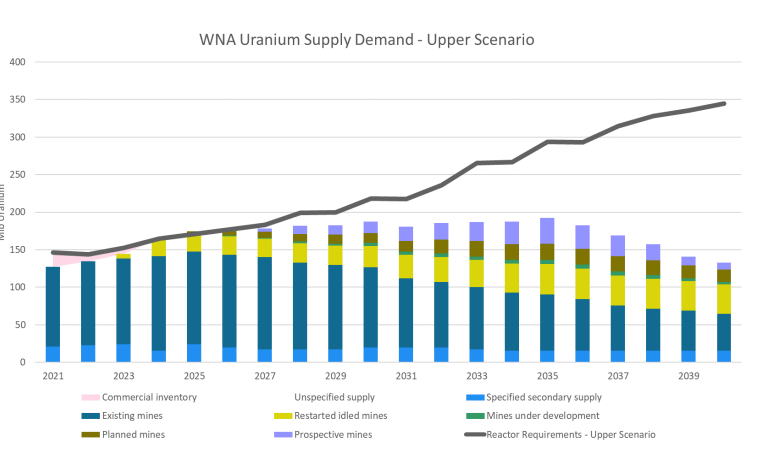
Conclusion
Nuclear power is one of the most efficient energy sources, and in a time of shortage and climate worry, many countries are reconsidering their previous doubts about nuclear energy.
Uranium could be the commodity that will benefit most from the steadily increasing demand for electricity.
The sector is very concentrated, with two large companies (Cameco & Kazatoprom) dominating the market, and the rest are either smaller companies with higher production costs or in the exploration/junior miner category.
If you wish to explore the potential of exploration-stage miners, check the infographic below, which analyzes uranium mines in development, comparing their total reserves, grades, and associated companies.
The website World Nuclear News (WNN) can also be a good source of information.
